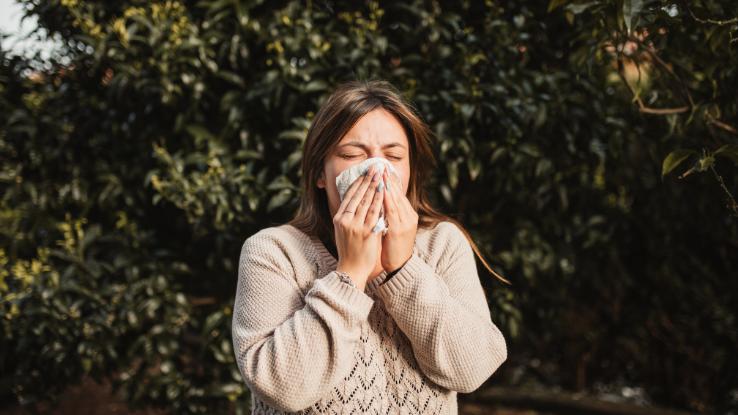Cumulative Review Chapters 1 -6 Geometry Page 101
Allergies 101: Types, Symptoms, Causes & Treatments

Approximately 50 meg Americans are affected by some form of allergy. Many substances in our surround tin trigger allergy symptoms, some of which are easier to avoid than others. An allergic reaction occurs when the immune arrangement mistakenly identifies a substance (an allergen) as harmful to the torso. The body's reaction to this "false alert" produces a series of unpleasant symptoms.
Depending on the type of allergy, symptoms can occur in the eyes, nose, throat, sinuses, lungs, in the lining of the tummy, or on the pare. Sometimes, the allergic reaction is severe, leading to breathing issues, serious skin rashes, or a life-threatening reaction called anaphylaxis. At other times, allergies symptoms, like itchy eyes and a runny nose, are much more manageable.
In the same way symptoms vary greatly, avoiding allergies or mitigating exposure to triggers can be tricky. Sometimes, it involves avoiding a particular substance, while, in other cases, patients tin can treat allergies using over-the-counter medications; medicines prescribed past a doctor; or allergy shots. All of this to say, it's of import to be prepared and sympathize your specific allergies more thoroughly.
Food Allergies: This type of allergy occurs when the torso misidentifies sure foods as harmful. Some common food allergens include peanuts, shellfish, soy, wheat, milk, and eggs. Many of these allergens (east.g. soy, wheat) are "hidden" in processed foods and can exist hard to place as the source of the allergic reaction. Food allergies affect up to eight per centum of children under the age of 3 years, and upwardly to three percent of adults.
Drug Allergies: This type of allergy occurs when the trunk misidentifies certain medications as harmful. Penicillin and antibiotics are the well-nigh common causes of drug allergies, merely pain relievers; anticonvulsants; insulin; drugs used to treat rheumatoid arthritis; and 10-ray contrast dyes can all trigger allergic reactions. Additionally, drug allergies can occur with over-the-counter medications and herbal supplements, non just medicines prescribed past your doctor.

Seasonal Allergies:
Also known as hay fever or allergic rhinitis, this type of allergy occurs when the body misidentifies pollen or mold particles as harmful. Because more of these particles are released during leap, summer, and fall, symptoms tend to develop or worsen at these times of the yr.
Allergic Dermatitis: This type of allergy occurs when the body misidentifies certain substances that are practical to or come up into contact with the pare. The nearly common allergens are chemicals found in soaps, detergents, and textile softeners, but allergy-causing substances can also be institute in pesticides, hair dyes, boom polish, shampoos, fragrances in perfumes or moisturizers, topical antibiotics, adhesives, rubber, latex, and metals plant in jewelry and other objects. Additionally, poison ivy, toxicant sumac, poison oak, and other found sensitivities autumn into this category.
Insect Sting Allergy: This type of allergy occurs when the body misidentifies the venom from an insect sting as harmful. While many people have a mild reaction, such every bit slight redness, swelling, and itchiness from a mosquito bite, others can experience more astringent, dangerous reactions. Stings from bees, wasps, hornets and fire ants are common triggers for this allergic response.
Symptoms of Allergies
The types of symptoms a person experiences is often related to the allergen to which they accept been exposed. For instance, when someone eats a food that they are allergic to, they will usually experience symptoms related to their digestive system, such every bit stomach cramps or diarrhea. Likewise, allergens that are inhaled typically issue in breathing, olfactory organ and pharynx problems, while allergens that touch the peel usually lead to hives, itching or rashes.

Allergies can produce a wide variety of symptoms, including:
- Coughing
- Shortness of breath
- Wheezing
- Chest tightness
- Runny olfactory organ
- Congestion
- Itchy olfactory organ, throat, oral cavity, eyes or skin
- Burning or watery eyes
- Conjunctivitis
- Stomach cramps
- Diarrhea
- Airsickness
- Pare rashes
- Skin swelling
- Urticaria (hives)
For people with more astringent allergies — ordinarily those related to foods or insect bites — a severe reaction called anaphylaxis may occur. This condition requires emergency medical care and may cause the following symptoms:
- Pare rash
- Swollen face up and airway
- Noisy animate
- Severe shortness of jiff
- Rapid, weak pulse
- Nausea and vomiting
- Lightheadedness
- Loss of consciousness
Untreated, anaphylaxis tin pb to decease.
Causes and Risk Factors
Allergic reactions begin in the immune system, which is designed to protect usa from harmful invading organisms, including bacteria and viruses, that accept potential to crusade disease. Allergies are acquired by the allowed system mistakenly identifying a substance (an allergen) as a harmful invader.
If you have an allergy, your immune system overreacts when it encounters the allergen past producing immunoglobulin E antibodies, which demark to specialized cells called mast cells, which then release a chemical called histamine. In plow, histamine triggers the allergic reaction. Mast cells are present in the optics, nose, mouth, throat, stomach, and skin — the sites involved in common allergy symptoms.

Some risk factors increment your chances of developing allergies, including:
- Being a child: Children are more than likely than adults to develop allergies. Sometimes children volition outgrow an allergy or the allergy will go away so come up back afterwards in life.
- Having asthma: People with asthma are more likely to develop an allergy.
- Having other allergies: People who have an allergy to something are more likely to develop other allergies.
- Having a family history of asthma or allergies: When a family fellow member has an allergy or asthma, information technology increases an private's hazard for developing an allergic condition. Both genetics (your family history) and your environment likely play a role in your potential allergy development.
Prevention & Treatment
The best way to foreclose an allergic reaction is to avert the allergen. Depending on the allergy, that could mean dissimilar things. If you suffer from seasonal or grit allergies, you could utilize a special air filter (east.g. a HEPA filter) to reduce allergens in the air, for instance. Additionally, keeping your habitation costless of dust, smoke, mold, mildew, and pet dander may help.
If you lot suffer from insect-sting allergies, wear light-colored habiliment that covers more than of your skin when outdoors. If you accept a food allergy, it might accept some time to identify the specific food that triggers a reaction earlier yous can eliminate it from your diet.

Many allergies are effectively treated with medications like corticosteroids, decongestants, antihistamines, leukotriene modifiers, and cromolyn sodium (a mast cell inhibitor). Both over-the-counter and prescription medications are bachelor, then ask your medico which medicine might work best for you.
In some cases, immunotherapy tin be administered via a serial of injections (allergy shots). This arroyo uses small amounts of the allergen to "train" your allowed organization to recognize information technology as non harmful. Immunotherapy may exist able to reduce the severity of an allergic condition over a number of years. Finally, those with severe allergies ofttimes have to carry an emergency epinephrine shot, an "EpiPen" with them. If a severe allergic reaction occurs, this injection can be used to reduce symptoms until emergency medical care arrives.
Although allergies are quite mutual, information technology's important to seek handling to reduce your symptoms and avoid potentially dangerous breathing problems. Those with astringent allergies should consider wearing a bracelet or other identifying accessory to alert others of their demand for immediate medical attending if a astringent allergic reaction occurs.
Resource Links
- "Allergies" via American University of Allergy Asthma & Immunology (AAAAI)
- "Allergic Reactions | Allergy Library" via American University of Allergy Asthma & Immunology (AAAAI)
- "Types of Allergies" via Global Allergy & Airways Patient Platform
- "Allergy" via MedlinePlus
- "Drug Allergy" via Mayo Clinic
- "Nutrient Allergy" via Mayo Clinic
- "Allergies — Symptoms & Causes" via Mayo Dispensary
- "Allergy-proof Your Abode" via Mayo Dispensary
- "Allergies — Insects: Bees, Wasps & Hornets" via Centers for Disease Control and Prevention (CDC)
- "Allergy Shots: Could They Help Your Allergies?" via FamilyDoctor.org
Source: https://www.symptomfind.com/health-conditions/allergies-condition?utm_content=params%3Ao%3D740013%26ad%3DdirN%26qo%3DserpIndex
0 Response to "Cumulative Review Chapters 1 -6 Geometry Page 101"
Post a Comment